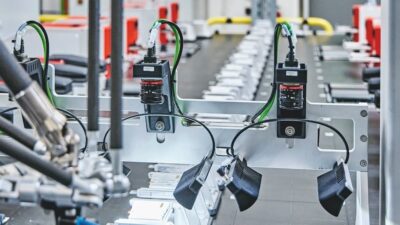This page offers a look back on a variety of interesting items from Control Engineering's past issues, highlighting content from 50, 25, and 10 years ago. March 1955 Stop coining words! "Superfluous words only create confusion," says Mr. J.J. Brown, who helped develop the first record-controlled machine tool and works for Aluminum Fiduciaries Ltd.
This page offers a look back on a variety of interesting items from Control Engineering ‘s past issues, highlighting content from 50, 25, and 10 years ago.
March 1955
Stop coining words!
“Superfluous words only create confusion,” says Mr. J.J. Brown, who helped develop the first record-controlled machine tool and works for Aluminum Fiduciaries Ltd.
“Rapid advance in any science is helped by good definitions. These definitions should be existing dictionary definitions, in order that today’s writing on the subject may tie closely with the writings of the past,” Brown claims.
“Yet, whenever a new subject appears, there is a tendency to coin words. This urge should be suppressed. The automatic production of goods and services is a complex subject, and ill-considered coinages like “automation” only add to the confusion.
“At a round table on the subject of automation,” Brown says, “I tried to make the point that the dictionary already contains a series of words adequate to describe all known forms of automatic control of processes and machines. But I had little success in persuading the industry members of the round table that we had perfectly good words. Since most of the men writing about the new mechanized plants are from industry, the word “automation” is catching on. This is bad. It is already causing unnecessary confusion. Occasionally there is a need for new scientific words, but this isn’t one of them.”
September 1979
Single-chip analog and digital signal processor
In the past, attempts to combine analog and digital components on a single chip have been thwarted by differing semiconductor technologies. If a true hybrid device containing both analog and digital circuitry in a single chip were to be developed, a way had to be found that would be compatible with both concepts. Intel’s solution is NMOS/LSI.
The new 2920 incorporates NMOS circuitry to perform the analog op amp, A/D conversion, and voltage reference functions with digital processing, all on a 28-pin chip.
2920 has been specifically designed to replace analog systems in real-time processing applications. It operates the analog circuitry simultaneously with the digital circuitry, thereby achieving the efficiency and speed needed for real-time processing. Advantages claimed for this approach include the elimination of several common analog system problems. Costly components linking precision resistors and capacitors will not be needed; circuit performance will not vary from one production run to another; performance degradation over time due to circuit integration or noise will be virtually eliminated—all because the digital signal processing is stable, predictable, and repeatable.
September 1994
Giants, machine control, and perspective
40 years from now, giants will dominate —George J. Blickley, then consulting editor, predicted what the business of controls would be like in 40 years: “Most growth will come from two activities. One will be mergers & acquisitions that will help surviving companies fill out the line of total capabilities. The other is alliances. Sometimes the cash is not there, or the smaller company is not quite ready to be gobbled up, but the market opportunities and joint proficiencies are just right for striking an alliance.”
Mechatronics, combined with ‘intellectual’ sensors, are seen to be shaping the future for machine control. Dr. J. Leonhard of the Technical University of Braunschweig, Germany, said, “It becomes obvious that engineering is advancing to a new quality of integration where mechanical, magnetic, electric, or thermal material properties are combined into an inseparable entity.”
Autonomous, truly distributed controllers can now communicate with other controllers as needed via individual addressing on a simple twisted-pair line. The communication capability is provided by controller area network (CAN) chipsets already available from a number of semiconductor companies. Expect these autonomous controllers to share data interactively that will lead to shared objectives. New software in the immediate future will track effects between multidiscipline systems that share data or energy, updating all data as necessary for control and business management.



